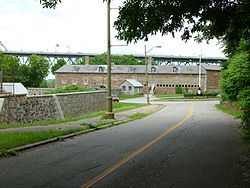- Fort de l'Île Sainte-Hélène
-
Fort de l'Île Sainte-Hélène 
Established 1955 Location Montreal, Quebec, Canada Type historical fort The Fort de l'Île Sainte-Hélène, an historic site on Saint Helen's Island that belongs to the city of Montreal, Quebec, was constructed in the early 1820s as an arsenal in the defensive chain of forts built to protect Canada from a threat of American invasion. Although not heavily fortified, it served an important purpose as the central artillery depot for all forts west. These included Fort Henry and Fort Lennox. The red stone used to build the Fort is a breccia quarried on the island, which is situated in the St. Lawrence River between the island of Montreal and the south shore.
The Levis Tower, contrary to popular belief, was not part of the fortifications on the island. It was built in the 1930s to house a water tower..[1]
Contents
History of the Fort
After the British Army left the fort for ruin, it became part of the City of Montreal. In the 1930s, it was restored as part of a job creation project during the Great Depression. During the Second World War, it was used as an internment camp for Italian Canadians. During the summer months the Fort houses two reconstituted 18th century regiments, The Olde 78th Fraser Highlanders, and Les Compagnies Franches de la Marine.
Today the Fort is also home the David M. Stewart Museum, an institution founded in 1955 to collect, store and display historical artefacts from Canada's colonial past, particularly that of New France. The museum collections include artefacts dating from the 16th century through to the 19th century. Both the Fort and the museum are open year-round.
David M. Stewart Museum
The museum, housed inside the garrison features a permanent exhibition and an annual one, usually opened in the spring months. During the summer months, the museum plays host to reconstituted 18th century regiments that perform daily military maneuvers. The regiments, the Olde 78th Fraser Highlanders and Les Compagnies Franches de la Marine perform daily musket drills, fife and drum and bagpipe shows.
The noon day gun salute is a tradition that was originally undertaken by British troops stationed at the fort. It use was to act as a form of synchronization for the city. The cannon fire signaled noon solar time. Today it is continued by museum staff dressed in the regimental dress of the Royal Artillery.
An encampment is set up next to the parade square simulating 18th century colonial life in New France. Bread is baked in a wood-fired oven daily as well as children's crafts and games are set up to give a hands-on approach to education of life during the 18th century.
References
- ^ "Tour De Lévis". Société du parc Jean-Drapeau. http://www.parcjeandrapeau.com/80-Tour_De_Levis-history-space.html. Retrieved 2009-10-18.
- Musée Stewart, Fort de l'Île Sainte-Hélène brochure, (Parks Canada, 2005).
External links
Coordinates: 45°31′02″N 73°32′01″W / 45.5171°N 73.5335°W
Topics of New France Subdivisions Acadia (1604–1713) • Canada (1608–1763) • Louisiana (1699–1763, 1800–1803) • Newfoundland (1662–1713) • Île Royale (1713–1763)
Towns Acadia (Port Royal) • Canada (Quebec, Trois-Rivières, Montreal, Détroit) • Île Royale (Louisbourg) • Louisiana (Mobile, New Orleans) • Newfoundland (Plaisance) • List of townsForts Fort Rouillé • Fort Michilimackinac • Fort de Buade;• Fort de Chartres • Fort Detroit • Fort Carillon • Fort Condé • Fort Duquesne • Fortress of Louisbourg • Castle Hill • List of FortsGovernment Canada (Governor General, Intendant, Sovereign Council, Bishop of Quebec, Governor of Trois-Rivières, Governor of Montreal) • Acadia (Governor, Lieutenant-General) • Newfoundland (Governor, Lieutenant-General) • Louisiana (Governor, Intendant, Superior Council) • Île Royale (Governor, Intendant, Superior Council)Justice Intendancy • Superior Council • Admiralty court • Provostship • Officiality • Seigneurial court • Attorney • Bailiff • Maréchaussée • Code NoirEconomy Society Religions War & Peace Intercolonial Wars • French and Iroquois Wars • Great Upheaval • Great Peace of Montreal • Schenectady massacre • Deerfield massacreRelated Categories:- 1820s architecture
- Museums in Montreal
- History museums in Canada
- Military and war museums in Canada
- Military forts in Quebec
- Quebec building and structure stubs
- Canada museum stubs
Wikimedia Foundation. 2010.
